Kuppan T. Heat Exchanger Design Handbook
Подождите немного. Документ загружается.

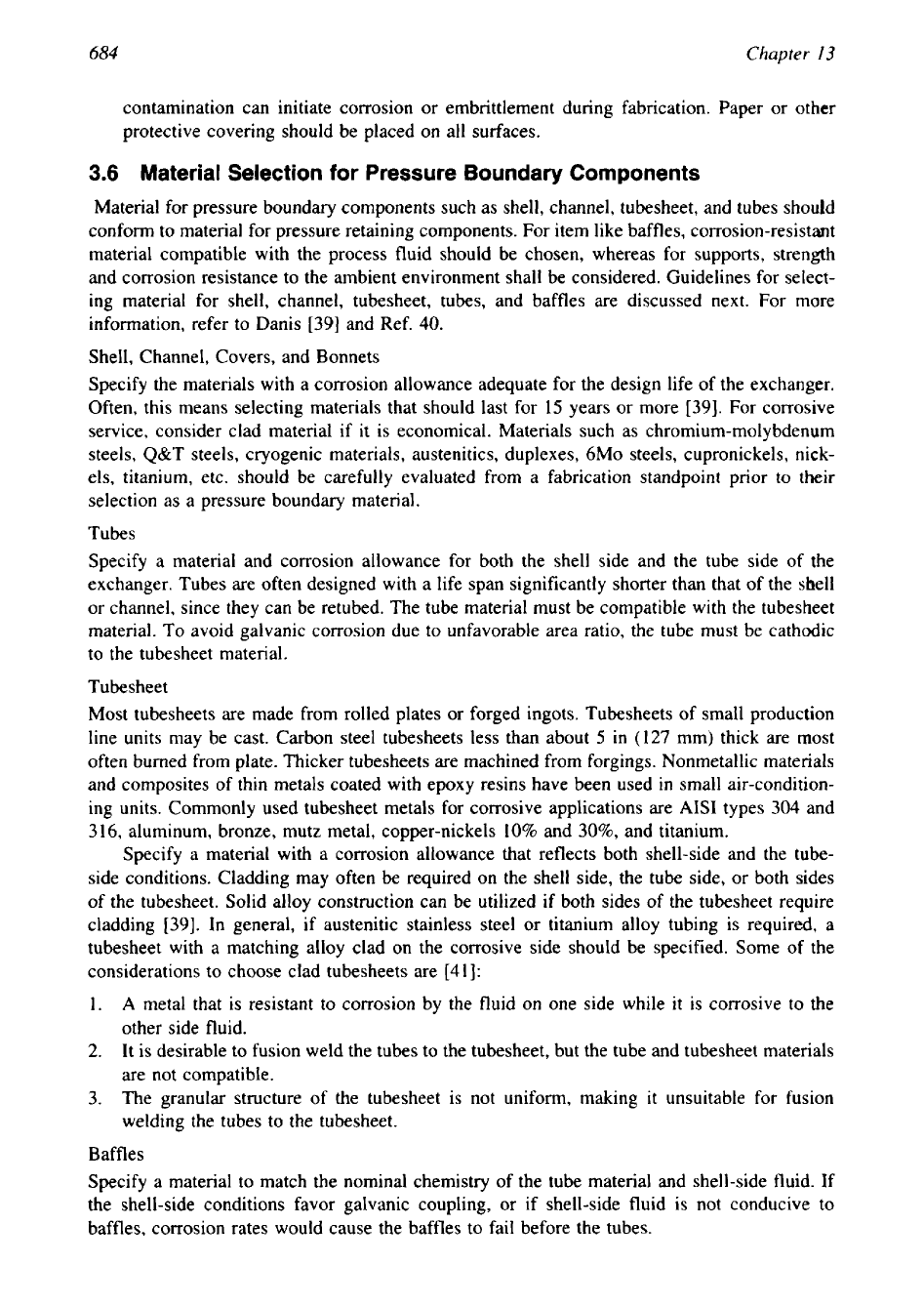
684
Chapter
I3
contamination can initiate corrosion or embrittlement during fabrication. Paper or other
protective covering should be placed on all surfaces.
3.6
Material Selection
for
Pressure Boundary Components
Material for pressure boundary components such as shell, channel, tubesheet, and tubes should
conform to material for pressure retaining components. For item like baffles, corrosion-resistant
material compatible with the process fluid should be chosen, whereas for supports, strength
and corrosion resistance to the ambient environment shall be considered. Guidelines for select-
ing material for shell, channel, tubesheet, tubes, and baffles are discussed next. For more
information, refer to Danis
[39]
and Ref.
40.
Shell, Channel, Covers, and Bonnets
Specify the materials with a corrosion allowance adequate for the design life of the exchanger.
Often, this means selecting materials that should last for
15
years or more
1391.
For corrosive
service, consider clad material if it is economical. Materials such as chromium-molybdenum
steels, Q&T steels, cryogenic materials, austenitics, duplexes,
6Mo
steels, cupronickels, nick-
els, titanium, etc. should be carefully evaluated from a fabrication standpoint prior to their
selection as a pressure boundary material.
Tubes
Specify a material and corrosion allowance for both the shell side and the tube side
of
the
exchanger. Tubes are often designed with a life span significantly shorter than that of the shell
or channel, since they can be retubed. The tube material must be compatible with the tubesheet
material.
To
avoid galvanic corrosion due to unfavorable area ratio, the tube must be cathodic
to the tubesheet material.
Tubes heet
Most tubesheets are made from rolled plates or forged ingots. Tubesheets of small production
line units may be cast. Carbon steel tubesheets less than about
5
in
(127
mm) thick are most
often burned from plate. Thicker tubesheets are machined from forgings. Nonmetallic materials
and composites of thin metals coated with epoxy resins have been used in small air-condition-
ing units. Commonly used tubesheet metals for corrosive applications are AISI types
304
and
316,
aluminum, bronze, mutz metal, copper-nickels 10% and
30%,
and titanium.
Specify a material with a corrosion allowance that reflects both shell-side and the tube-
side conditions. Cladding may often be required on the shell side, the tube side, or both sides
of the tubesheet. Solid alloy construction can be utilized if both sides of the tubesheet require
cladding
[39].
In general, if austenitic stainless steel or titanium alloy tubing is required, a
tubesheet with a matching alloy clad on the corrosive side should be specified. Some of the
considerations to choose clad tubesheets are
[41]:
1.
A
metal that is resistant to corrosion by the fluid on one side while it is corrosive to the
other side fluid.
2.
It is desirable to fusion weld the tubes to the tubesheet, but the tube and tubesheet materials
are not compatible.
3.
The granular structure
of
the tubesheet is not uniform, making it unsuitable for fusion
welding the tubes to the tubesheet.
Baffles
Specify a material to match the nominal chemistry of the tube material and shell-side fluid. If
the shell-side conditions favor galvanic coupling, or if shell-side fluid is not conducive to
baffles, corrosion rates would cause the baffles to fail before the tubes.
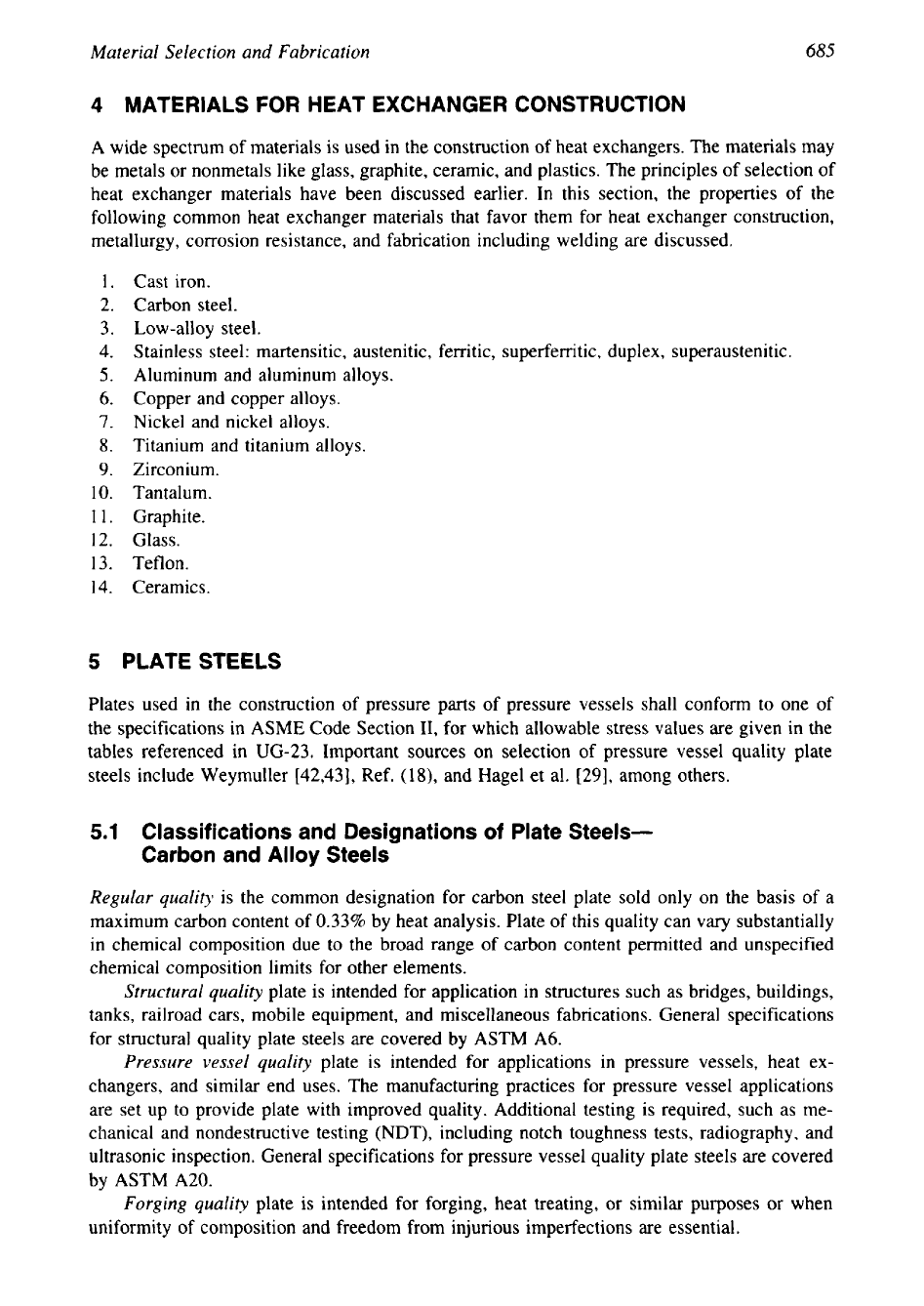
Material Selection and Fabrication
685
4
MATERIALS
FOR
HEAT EXCHANGER CONSTRUCTION
A
wide spectrum of materials is used in the construction of heat exchangers. The materials may
be metals or nonmetals like glass, graphite, ceramic, and plastics. The principles of selection of
heat exchanger materials have been discussed earlier. In this section, the properties of the
following common heat exchanger materials that favor them for heat exchanger construction,
metallurgy, corrosion resistance, and fabrication including welding are discussed.
1.
2.
3.
4.
5.
6.
7.
8.
9.
10.
11.
12.
13.
14.
Cast iron.
Carbon steel.
Low-alloy steel.
Stainless steel: martensitic, austenitic, ferritic, superferritic, duplex, superaustenitic.
Aluminum and aluminum alloys.
Copper and copper alloys.
Nickel and nickel alloys.
Titanium and titanium alloys.
Zirconium.
Tantalum.
Graphite
.
Glass.
Teflon.
Ceramics.
5
PLATESTEELS
Plates used in the construction
of
pressure parts
of
pressure vessels shall conform to one of
the specifications in
ASME
Code Section 11, for which allowable stress values are given in the
tables referenced in UG-23. Important sources on selection of pressure vessel quality plate
steels include Weymuller [42,43], Ref. (18), and Hagel et al. [29], among others.
5.1
Classifications and Designations of Plate Steels-
Carbon and
Alloy Steels
Regular quality
is the common designation for carbon steel plate sold only on the basis of a
maximum carbon content of 0.33% by heat analysis. Plate of this quality can
vary
substantially
in chemical composition due to the broad range of carbon content permitted and unspecified
chemical composition limits for other elements.
Structural quality
plate is intended for application in structures such as bridges, buildings,
tanks, railroad cars, mobile equipment, and miscellaneous fabrications. General specifications
for structural quality plate steels are covered by ASTM
A6.
Pressure
vessel quality
plate is intended for applications in pressure vessels, heat ex-
changers, and similar end uses. The manufacturing practices for pressure vessel applications
are set up to provide plate with improved quality. Additional testing is required, such as me-
chanical and nondestructive testing (NDT), including notch toughness tests, radiography, and
ultrasonic inspection. General specifications for pressure vessel quality plate steels are covered
by
ASTM
A20.
Forging quality
plate is intended for forging, heat treating,
or
similar purposes
or
when
uniformity of composition and freedom from injurious imperfections are essential.
Material Selection and Fabrication
685
4
MATERIALS
FOR
HEAT EXCHANGER CONSTRUCTION
A
wide spectrum of materials is used in the construction of heat exchangers. The materials may
be metals or nonmetals like glass, graphite, ceramic, and plastics. The principles of selection of
heat exchanger materials have been discussed earlier. In this section, the properties of the
following common heat exchanger materials that favor them for heat exchanger construction,
metallurgy, corrosion resistance, and fabrication including welding are discussed.
1.
Cast iron.
2.
Carbon steel.
3.
Low-alloy steel.
4.
Stainless steel: martensitic, austenitic, ferritic, superferritic, duplex, superaustenitic.
5.
Aluminum and aluminum alloys.
6.
Copper and copper alloys.
7.
Nickel and nickel alloys.
8.
Titanium and titanium alloys.
9.
Zirconium.
10.
Tantalum.
11.
Graphite
.
12.
Glass.
13.
Teflon.
14.
Ceramics.
5
PLATESTEELS
Plates used in the construction
of
pressure parts
of
pressure vessels shall conform to one of
the specifications in
ASME
Code Section 11, for which allowable stress values are given in the
tables referenced in UG-23. Important sources on selection of pressure vessel quality plate
steels include Weymuller [42,43], Ref. (18), and Hagel et al. [29], among others.
5.1
Classifications and Designations of Plate Steels-
Carbon and
Alloy Steels
Regular quality
is the common designation for carbon steel plate sold only on the basis of a
maximum carbon content of 0.33% by heat analysis. Plate of this quality can
vary
substantially
in chemical composition due to the broad range of carbon content permitted and unspecified
chemical composition limits for other elements.
Structural quality
plate is intended for application in structures such as bridges, buildings,
tanks, railroad cars, mobile equipment, and miscellaneous fabrications. General specifications
for structural quality plate steels are covered by ASTM
A6.
Pressure
vessel quality
plate is intended for applications in pressure vessels, heat ex-
changers, and similar end uses. The manufacturing practices for pressure vessel applications
are set up to provide plate with improved quality. Additional testing is required, such as me-
chanical and nondestructive testing (NDT), including notch toughness tests, radiography, and
ultrasonic inspection. General specifications for pressure vessel quality plate steels are covered
by
ASTM
A20.
Forging quality
plate is intended for forging, heat treating,
or
similar purposes
or
when
uniformity of composition and freedom from injurious imperfections are essential.
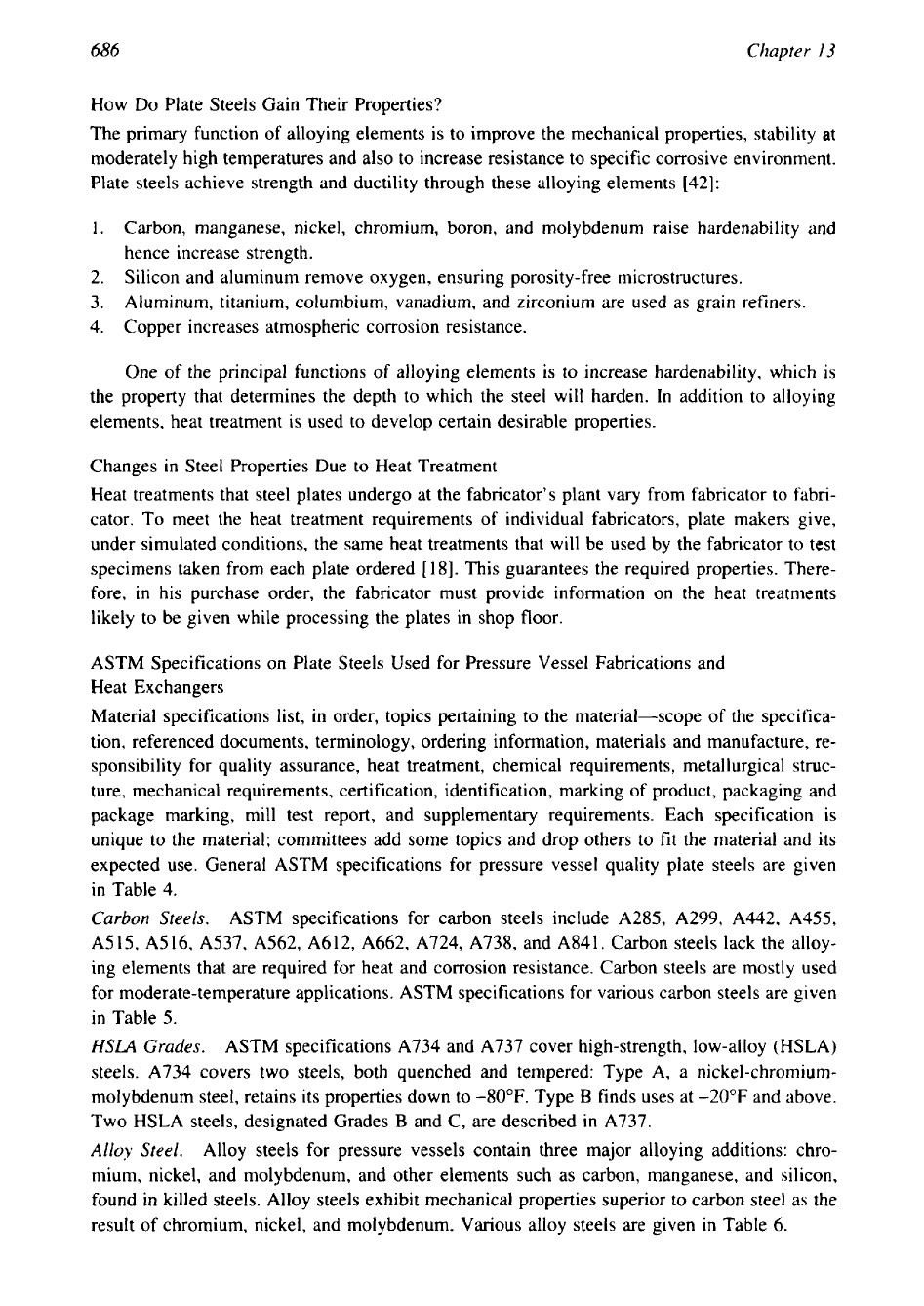
686
Chapter
13
How
Do
Plate Steels Gain Their Properties?
The primary function of alloying elements is to improve the mechanical properties, stability
at
moderately high temperatures and also to increase resistance to specific corrosive environment.
Plate steels achieve strength and ductility through these alloying elements [42]:
1.
Carbon, manganese, nickel, chromium, boron, and molybdenum raise hardenability and
hence increase strength.
2.
Silicon and aluminum remove oxygen, ensuring porosity-free microstructures.
3.
Aluminum, titanium, columbium, vanadium, and zirconium are used as grain refiners.
4.
Copper increases atmospheric corrosion resistance.
One of the principal functions of alloying elements is to increase hardenability, which
is
the property that determines the depth to which the steel will harden. In addition to alloying
elements, heat treatment is used to develop certain desirable properties.
Changes
in
Steel Properties Due to Heat Treatment
Heat treatments that steel plates undergo at the fabricator’s plant
vary
from fabricator to fabri-
cator. To meet the heat treatment requirements of individual fabricators, plate makers give,
under simulated conditions, the same heat treatments that will be used by the fabricator to test
specimens taken from each plate ordered
[
181.
This guarantees the required properties. There-
fore, in his purchase order, the fabricator must provide information
on
the heat treatments
likely to be given while processing the plates in shop floor.
ASTM Specifications on Plate Steels Used for Pressure Vessel Fabrications and
Heat Exchangers
Material specifications list, in order, topics pertaining to the material-scope of the specifica-
tion, referenced documents, terminology, ordering information, materials and manufacture, re-
sponsibility for quality assurance, heat treatment, chemical requirements, metallurgical struc-
ture, mechanical requirements, certification, identification, marking of product, packaging and
package marking, mill test report, and supplementary requirements. Each specification is
unique to the material; committees add some topics and drop others to
fit
the material and its
expected use. General ASTM specifications for pressure vessel quality plate steels are given
in
Table 4.
Carbon
Steels.
ASTM specifications for carbon steels include A285, A299, A442, A455,
A515, A516, A537, A562, A612, A662, A724, A738, and A841. Carbon steels lack the alloy-
ing elements that are required for heat and corrosion resistance. Carbon steels are mostly used
for moderate-temperature applications. ASTM specifications for various carbon steels are given
in
Table
5.
HSLA
Grades.
ASTM specifications A734 and A737 cover high-strength, low-alloy (HSLA)
steels. A734 covers two steels, both quenched and tempered: Type A, a nickel-chromium-
molybdenum steel, retains its properties down to
-80°F.
Type
B
finds uses at -20°F and above.
Two HSLA steels, designated Grades
B
and C, are described in A737.
Alloy Steel.
Alloy steels for pressure vessels contain three major alloying additions: chro-
mium, nickel, and molybdenum, and other elements such as carbon, manganese, and silicon,
found
in
killed steels. Alloy steels exhibit mechanical properties superior
to
carbon steel as the
result of chromium, nickel, and molybdenum. Various alloy steels are given in Table
6.
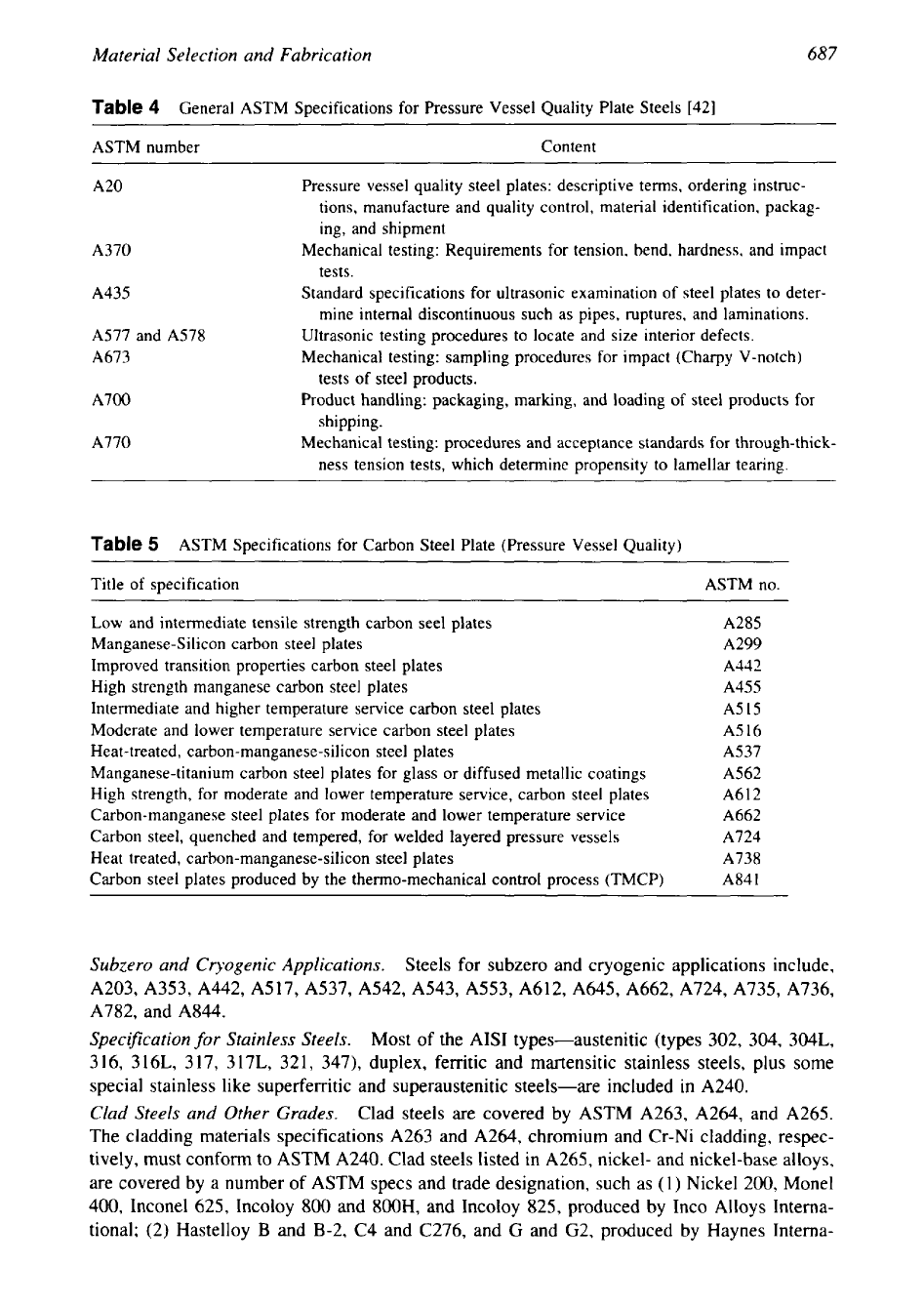
687
Material Selection and Fabrication
Table
4
General ASTM Specifications for Pressure Vessel Quality Plate Steels [42]
~~
ASTM number Content
A20
Pressure vessel quality steel plates: descriptive terms, ordering instruc-
tions, manufacture and quality control, material identification, packag-
ing, and shipment
A370
Mechanical testing: Requirements for tension, bend, hardness, and impact
tests.
A435
Standard specifications for ultrasonic examination of steel plates to deter-
mine internal discontinuous such as pipes, ruptures, and laminations.
A577 and A578
Ultrasonic testing procedures to locate and size interior defects.
A673
Mechanical testing: sampling procedures for impact (Charpy V-notch)
tests of steel products.
A700
Product handling: packaging, marking, and loading of steel products for
shipping.
A770
Mechanical testing: procedures and acceptance standards for through-thick-
ness tension tests, which determine propensity to lamellar tearing.
Table
5
ASTM Specifications for Carbon Steel Plate (Pressure Vessel Quality)
Title of specification ASTM no.
Low and intermediate tensile strength carbon see1 plates
A285
Manganese-Silicon carbon steel plates
A299
Improved transition properties carbon steel plates
A442
High strength manganese carbon steel plates
A455
Intermediate and higher temperature service carbon steel plates
A5
15
Moderate and lower temperature service carbon steel plates
A516
Heat-treated, carbon-manganese-silicon steel plates
A537
Manganese-titanium carbon steel plates for glass or diffused metallic coatings
A562
High strength, for moderate and lower temperature service, carbon steel plates
A612
Carbon-manganese steel plates for moderate and lower temperature service
A662
Carbon steel, quenched and tempered, for welded layered pressure vessels
A724
Heat treated, carbon-manganese-silicon steel plates
A738
Carbon steel plates produced by the thermo-mechanical control process (TMCP)
A84
1
Subzero and Cryogenic Applications.
Steels for subzero and cryogenic applications include,
A203, A353, A442, A517, A537, A542, A543, A553, A612, A645, A662, A724, A735, A736,
A782,
and
A844.
Specification
for
Stainless Steels.
Most of the
AISI
types-austenitic (types
302, 304, 304L,
316, 316L, 317, 317L, 321, 347),
duplex, ferritic and martensitic stainless steels, plus some
special stainless like superferritic and superaustenitic steels-are included in
A240.
Clad Steels and Other Grades.
Clad steels are covered by
ASTM A263, A264,
and
A265.
The cladding materials specifications
A263
and
A264,
chromium and Cr-Ni cladding, respec-
tively, must conform to
ASTM
A240.
Clad steels listed in
A265,
nickel- and nickel-base alloys,
are covered by a number of
ASTM
specs and trade designation, such as
(1)
Nickel
200,
Monel
400,
Inconel
625,
Incoloy
800
and
800H,
and Incoloy
825,
produced by Inco Alloys Interna-
tional;
(2)
Hastelloy
B
and
B-2,
C4
and
C276,
and
G
and
G2,
produced by Haynes Interna-
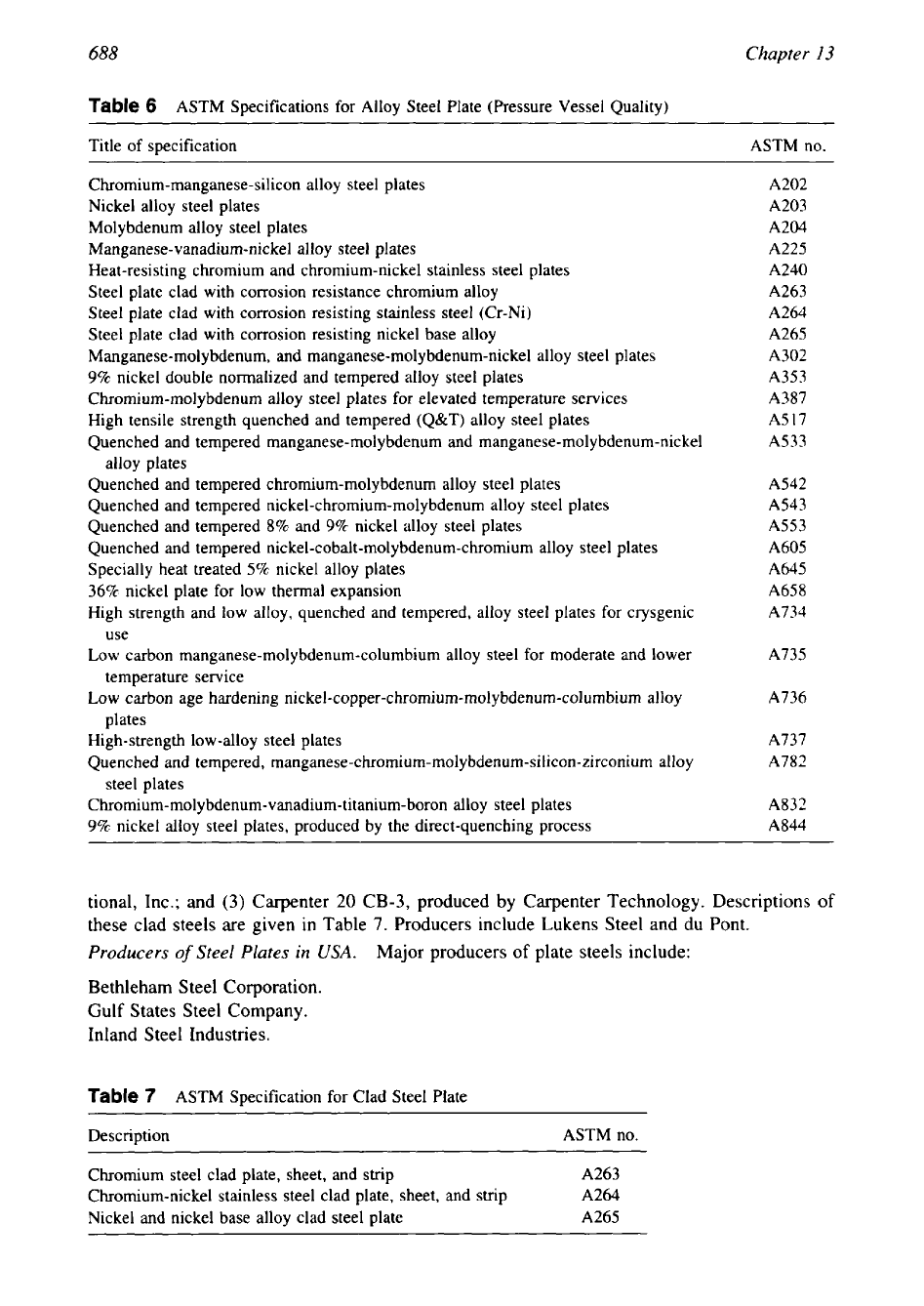
688
Chapter
13
Table
6
ASTM
Specifications for Alloy Steel Plate (Pressure Vessel Quality)
Title of specification
ASTM
no.
Chromium-manganese-silicon alloy steel plates
A202
Nickel alloy steel plates
A203
Molybdenum alloy steel plates
A204
Manganese-vanadium-nickel alloy steel plates
A225
Heat-resisting chromium and chromium-nickel stainless steel plates
A240
Steel plate clad with corrosion resistance chromium alloy
A263
Steel plate clad with corrosion resisting stainless steel (Cr-Ni)
A264
Steel plate clad with corrosion resisting nickel base alloy
A265
Manganese-molybdenum, and manganese-molybdenum-nickel alloy steel plates
A302
9%
nickel double normalized and tempered alloy steel plates
A353
Chromium-molybdenum alloy steel plates for elevated temperature services
A387
High tensile strength quenched and tempered (Q&T) alloy steel plates
A517
Quenched and tempered manganese-molybdenum and manganese-molybdenum-nickel
A533
alloy plates
Quenched and tempered chromium-molybdenum alloy steel plates
A542
Quenched and tempered nickel-chromium-molybdenum alloy steel plates
A543
Quenched and tempered
8%
and
9%
nickel alloy steel plates
A553
Quenched and tempered nickel-cobalt-molybdenum-chromium alloy steel plates
A605
Specially heat treated
5%
nickel alloy plates
A645
36%
nickel plate for low thermal expansion
A65
8
High strength and low alloy, quenched and tempered, alloy steel plates for crysgenic
A734
use
Low carbon manganese-molybdenum-columbium alloy steel for moderate and lower
A735
temperature service
Low carbon age hardening
nickel-copper-chromium-molybdenum-columbium
alloy
A736
plates
High-strength low-alloy steel plates
A737
Quenched and tempered, manganese-chromium-molybdenum-silicon-zirconium alloy
A782
steel plates
Chromium-molybdenum-vanadium-titanium-boron alloy steel plates
A832
9%
nickel alloy steel plates, produced by the direct-quenching process
A844
tional, Inc.; and (3) Carpenter
20
CB-3, produced by Carpenter Technology. Descriptions
of
these clad steels are given in Table
7.
Producers include Lukens Steel and du Pont.
Producers
of
Steel Plates
in
USA.
Major producers
of
plate steels include:
I
Bethleham Steel Corporation.
Gulf States Steel Company.
Inland Steel Industries.
Table
7
ASTM
Specification for Clad Steel Plate
Description
ASTM
no.
Chromium steel clad plate, sheet, and strip
A263
Chromium-nickel stainless steel clad plate, sheet, and strip
A264
Nickel and nickel base alloy clad steel plate
A265
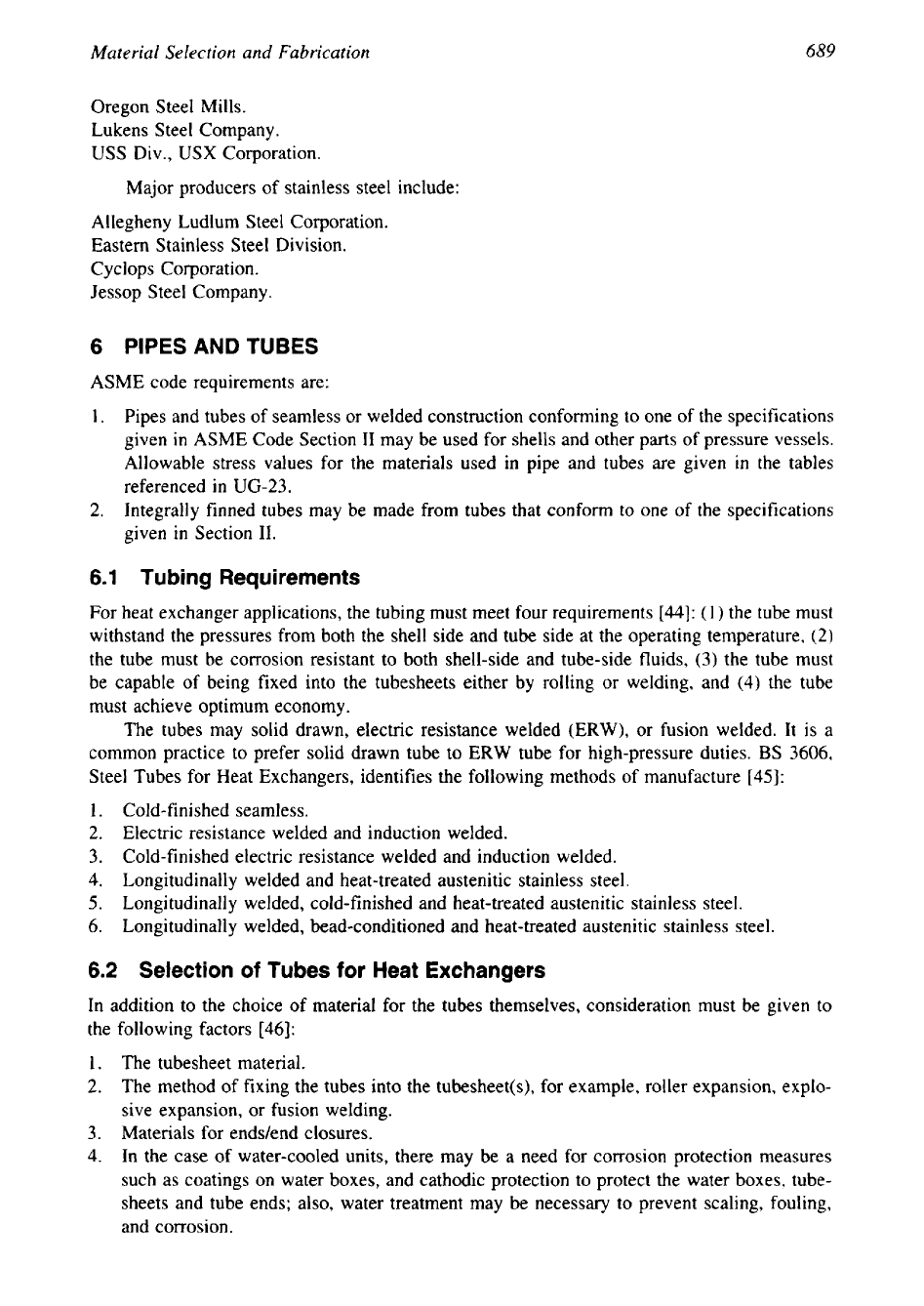
Material Selection and Fabrication
689
Oregon Steel Mills.
Lukens Steel Company.
USS
Div.,
USX
Corporation.
Major producers of stainless steel include:
Allegheny Ludlum Steel Corporation.
Eastern Stainless Steel Division.
Cyclops Corporation.
Jessop Steel Company.
6
PIPES
AND
TUBES
ASME code requirements are:
1.
Pipes and tubes of seamless or welded construction conforming to one of the specifications
given in ASME Code Section I1 may be used for shells and other parts of pressure vessels.
Allowable stress values for the materials used in pipe and tubes are given in the tables
referenced in
UG-23.
2.
Integrally finned tubes may be made from tubes that conform to one of the specifications
given in Section
11.
6.1
Tubing Requirements
For heat exchanger applications, the tubing must meet four requirements [44]:
(1)
the tube must
withstand the pressures from both the shell side and tube side at the operating temperature,
(2)
the tube must be corrosion resistant to both shell-side and tube-side fluids, (3) the tube must
be capable of being fixed into the tubesheets either by rolling or welding, and
(4)
the tube
must achieve optimum economy.
The tubes may solid drawn, electric resistance welded (ERW), or fusion welded. It is a
common practice to prefer solid drawn tube to
ERW
tube for high-pressure duties.
BS
3606,
Steel Tubes for Heat Exchangers, identifies the following methods of manufacture [45]:
1.
Cold-finished seamless.
2.
Electric resistance welded and induction welded.
3.
Cold-finished electric resistance welded and induction welded.
4.
Longitudinally welded and heat-treated austenitic stainless steel.
5.
Longitudinally welded, cold-finished and heat-treated austenitic stainless steel.
6.
Longitudinally welded, bead-conditioned and heat-treated austenitic stainless steel.
6.2 Selection
of
Tubes
for
Heat Exchangers
In addition to the choice of material for the tubes themselves, consideration must be given to
the following factors
[46]:
1.
The tubesheet material.
2.
The method of fixing the tubes into the tubesheet(s), for example, roller expansion, explo-
sive expansion, or fusion welding.
3. Materials for ends/end closures.
4.
In the case of water-cooled units, there may be a need for corrosion protection measures
such as coatings on water boxes, and cathodic protection to protect the water boxes, tube-
sheets and tube ends; also, water treatment may be necessary to prevent scaling, fouling,
and corrosion.
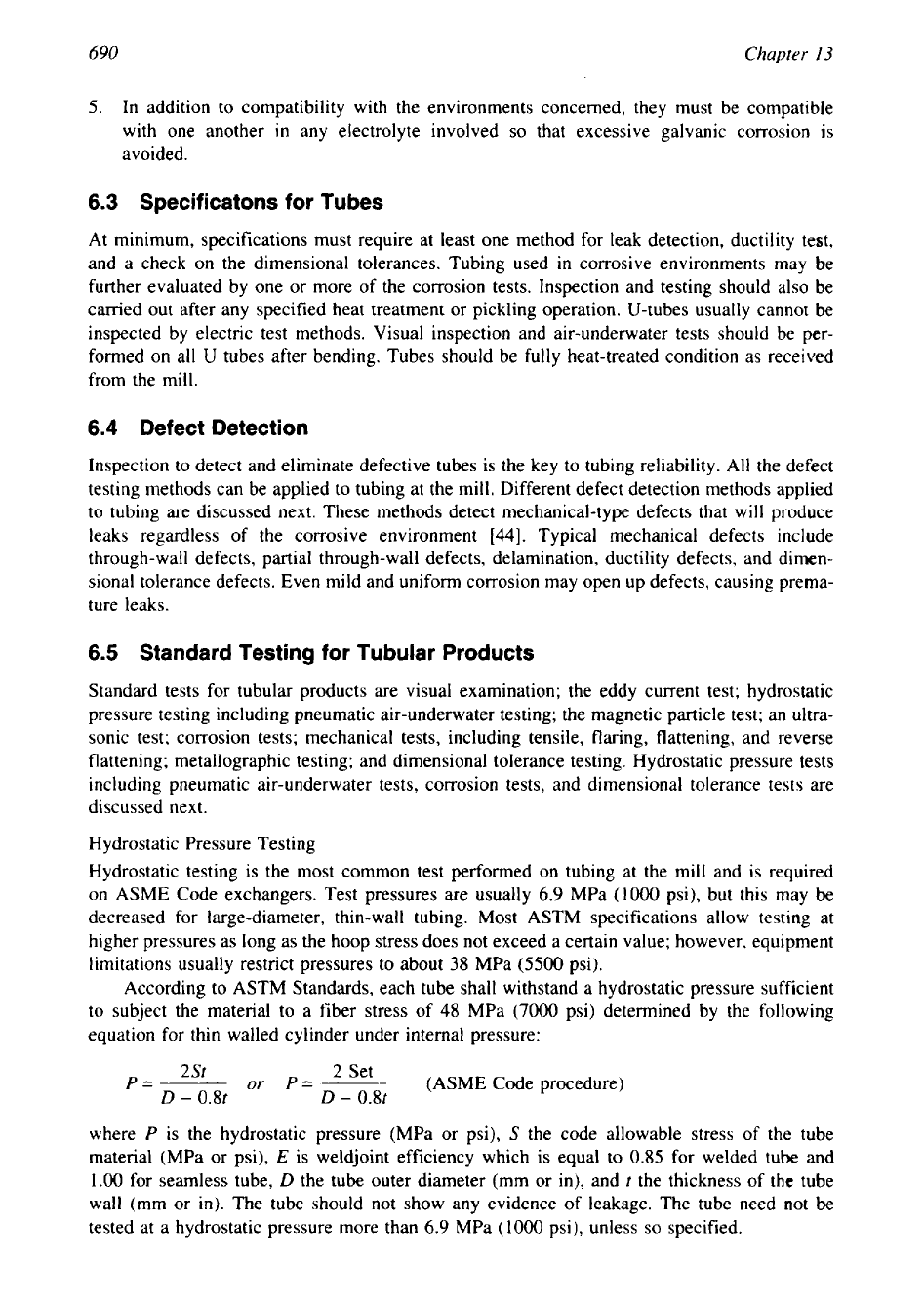
690
Chapter
I3
5.
In
addition to compatibility with the environments concerned, they must be compatible
with one another
in
any electrolyte involved
so
that excessive galvanic corrosion
is
avoided.
6.3
Specificatons for Tubes
At minimum, specifications must require at least one method for leak detection, ductility test,
and a check on the dimensional tolerances. Tubing used in corrosive environments may be
further evaluated by one or more of the corrosion tests. Inspection and testing should also be
carried out after any specified heat treatment or pickling operation. U-tubes usually cannot be
inspected by electric test methods. Visual inspection and air-underwater tests should be per-
formed on all U tubes after bending, Tubes should be fully heat-treated condition
as
received
from the mill.
6.4
Defect Detection
Inspection to detect and eliminate defective tubes is the key to tubing reliability.
All
the defect
testing methods can be applied to tubing at the mill. Different defect detection methods applied
to tubing are discussed next. These methods detect mechanical-type defects that will produce
leaks regardless of the corrosive environment
[44].
Typical mechanical defects include
through-wall defects, partial through-wall defects, delamination, ductility defects, and dimen-
sional tolerance defects. Even mild and uniform corrosion may open up defects, causing prema-
ture leaks.
6.5
Standard Testing
for
Tubular Products
Standard tests for tubular products are visual examination; the eddy current test; hydrostatic
pressure testing including pneumatic air-underwater testing; the magnetic particle test; an ultra-
sonic test; corrosion tests; mechanical tests, including tensile, flaring, flattening, and reverse
flattening; metallographic testing; and dimensional tolerance testing. Hydrostatic pressure tests
including pneumatic air-underwater tests, corrosion tests, and dimensional tolerance tests are
discussed next.
Hydrostatic Pressure Testing
Hydrostatic testing is the most common test performed on tubing at the mill and is required
on ASME Code exchangers. Test pressures are usually
6.9
MPa
(1000
psi), but this may
be
decreased for large-diameter, thin-wall tubing. Most ASTM specifications allow testing at
higher pressures as long as the hoop stress does not exceed a certain value; however, equipment
limitations usually restrict pressures to about
38
MPa
(5500
psi).
According to ASTM Standards, each tube shall withstand a hydrostatic pressure sufficient
to subject the material to a fiber stress of
48
MPa
(7000
psi) determined by the following
equation for thin walled cylinder under internal pressure:
2St
p=-------
or
P=-------
Set
(ASME
Code procedure)
D
-
0.81
D
-
0.8t
where
P
is the hydrostatic pressure (MPa or psi),
S
the code allowable stress of the tube
material (MPa or psi),
E
is weldjoint efficiency which is equal to
0.85
for welded
tube
and
1.00
for seamless tube,
D
the tube outer diameter (mm or
in),
and
t
the thickness of the tube
wall (mm or in). The tube should not show any evidence of leakage. The tube need
not
be
tested at a hydrostatic pressure more than
6.9
MPa
(1000
psi), unless
so
specified.
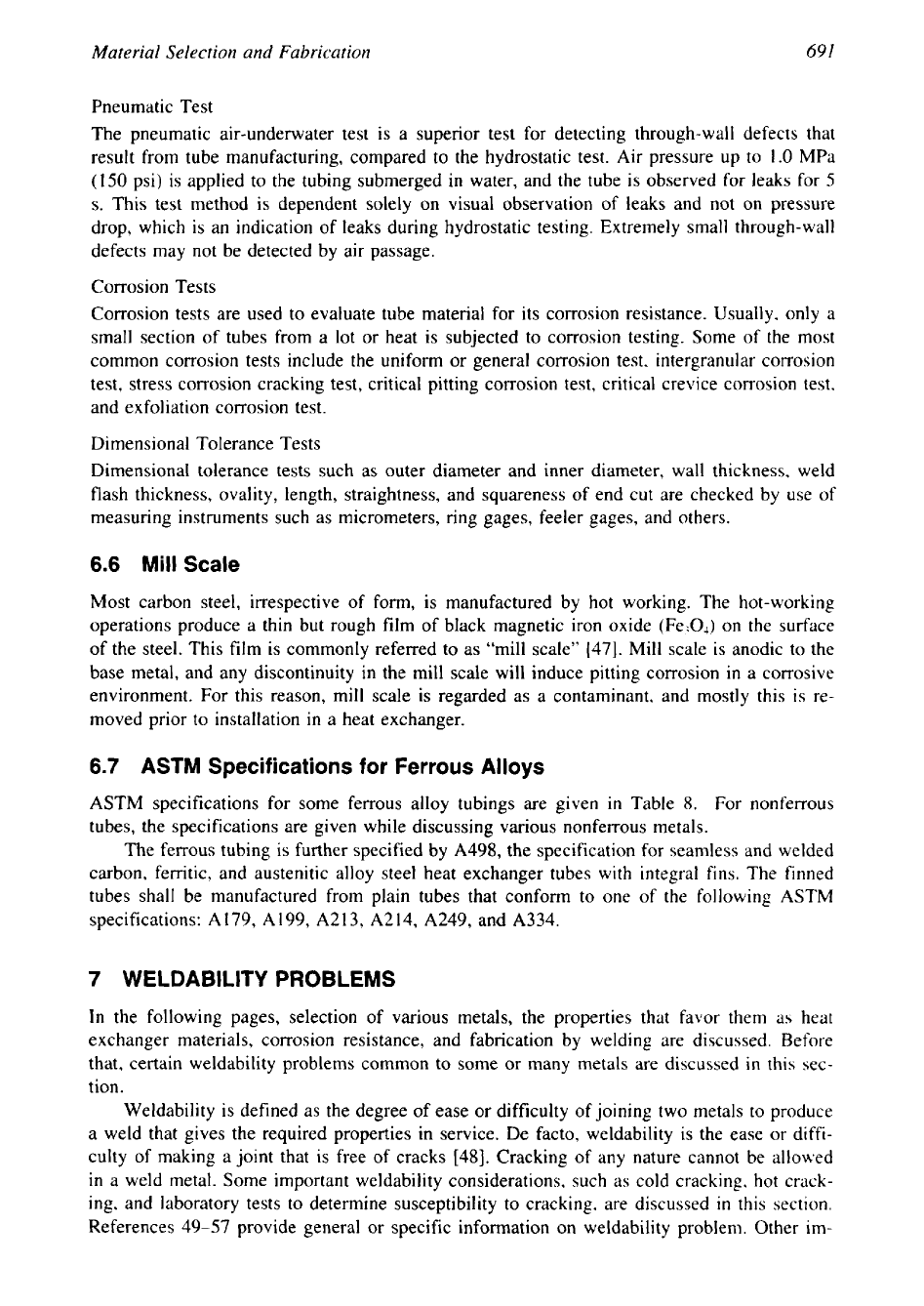
Material Selection
and
Fabrication
691
Pneumatic Test
The pneumatic air-underwater test is a superior test for detecting through-wall defects that
result from tube manufacturing, compared to the hydrostatic test. Air pressure up
to
1.0
MPa
(150
psi) is applied to the tubing submerged in water, and the tube is observed for leaks for
5
s.
This test method is dependent solely on visual observation of leaks and not on pressure
drop, which is an indication of leaks during hydrostatic testing. Extremely small through-wall
defects may not be detected by air passage.
Corrosion Tests
Corrosion tests are used to evaluate tube material for its corrosion resistance. Usually, only a
small section of tubes from a lot or heat is subjected to corrosion testing. Some of the most
common corrosion tests include the uniform or general corrosion test, intergranular corrosion
test, stress corrosion cracking test, critical pitting corrosion test, critical crevice corrosion test,
and exfoliation corrosion test.
Dimensional Tolerance Tests
Dimensional tolerance tests such as outer diameter and inner diameter, wall thickness, weld
flash thickness, ovality, length, straightness, and squareness of end cut are checked by use of
measuring instruments such as micrometers, ring gages, feeler gages, and others.
6.6
Mill Scale
Most carbon steel, irrespective of form, is manufactured by hot working. The hot-working
operations produce a
thin
but rough film of black magnetic iron oxide (Fe30,) on the surface
of the steel. This film is commonly referred to as “mill scale” [47].
Mill
scale is anodic to the
base metal, and any discontinuity
in
the mill scale will induce pitting corrosion in a corrosive
environment. For this reason, mill scale
is
regarded as a contaminant, and mostly this is re-
moved prior to installation
in
a heat exchanger.
6.7
ASTM
Specifications
for Ferrous
Alloys
ASTM specifications for some ferrous alloy tubings
are
given
in
Table
8.
For nonferrous
tubes, the specifications are given while discussing various nonferrous metals.
The ferrous tubing
is
further specified by A498, the specification for seamless and welded
carbon, ferritic, and austenitic alloy steel heat exchanger tubes with integral fins. The finned
tubes shall be manufactured from plain tubes that conform to one of the following ASTM
specifications: A179, A199, A213, A214, A249, and A334.
7
WELDABILITY PROBLEMS
In the following pages, selection of various metals, the properties that favor them as heat
exchanger materials, corrosion resistance, and fabrication by welding are discussed. Before
that, certain weldability problems common to some or many metals are discussed
in
this sec-
tion.
Weldability is defined as the degree of ease
or
difficulty of joining two metals to produce
a weld that gives the required properties in service. De facto, weldability
is
the ease or diffi-
culty of making a joint that is free of cracks [48]. Cracking
of
any nature cannot be allowed
in
a weld metal. Some important weldability considerations, such as cold cracking, hot crack-
ing, and laboratory tests to determine susceptibility to cracking, are discussed
in
this section.
References 49-57 provide general or specific information on weldability problem. Other im-
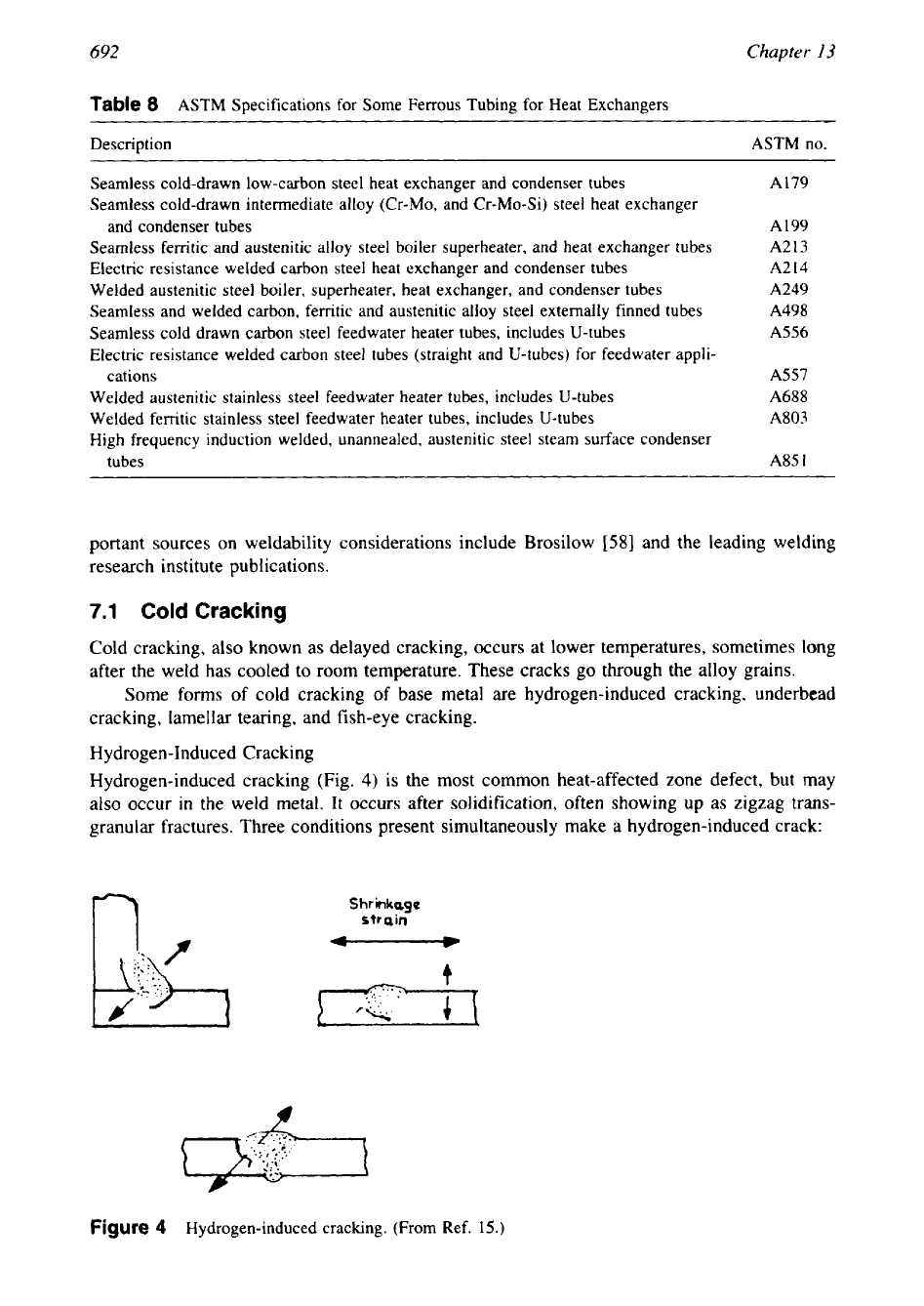
692
Chapter
I3
Table
8
ASTM
Specifications for Some Ferrous Tubing for Heat Exchangers
Description
ASTM
no.
Seamless cold-drawn low-carbon steel heat exchanger and condenser tubes
A179
Seamless cold-drawn intermediate alloy (Cr-MO, and Cr-Mo-Si) steel heat exchanger
and condenser tubes
A199
Seamless ferritic and austenitic alloy steel boiler superheater, and heat exchanger tubes
A213
Electric resistance welded carbon steel heat exchanger and condenser tubes
A214
Welded austenitic steel boiler, superheater, heat exchanger, and condenser tubes
A249
Seamless and welded carbon, ferritic and austenitic alloy steel externally finned tubes
A498
Seamless cold drawn carbon steel feedwater heater tubes, includes U-tubes
A556
Electric resistance welded carbon steel tubes (straight and U-tubes) for feedwater appli-
cations
A557
Welded austenitic stainless steel feedwater heater tubes, includes U-tubes
A688
Welded ferritic stainless steel feedwater heater tubes, includes U-tubes
A803
High frequency induction welded, unannealed, austenitic steel steam surface condenser
tubes
A85
1
portant sources on weldability considerations include Brosilow
[58
J
and the leading welding
research institute publications.
7.1
Cold
Cracking
Cold cracking, also known as delayed cracking, occurs at lower temperatures, sometimes long
after the weld has cooled to room temperature. These cracks
go
through the alloy grains.
Some
forms of cold cracking of base metal are hydrogen-induced cracking, underbead
cracking, lamellar tearing, and fish-eye cracking.
Hydrogen-Induced Cracking
Hydrogen-induced cracking (Fig.
4)
is the most common heat-affected zone defect, but may
also occur
in
the weld metal. It occurs after solidification, often showing up as zigzag trans-
granular fractures. Three conditions present simultaneously make a hydrogen-induced crack:
n
Shrinkage
strain
Figure
4
Hydrogen-induced cracking. (From Ref.
15.)
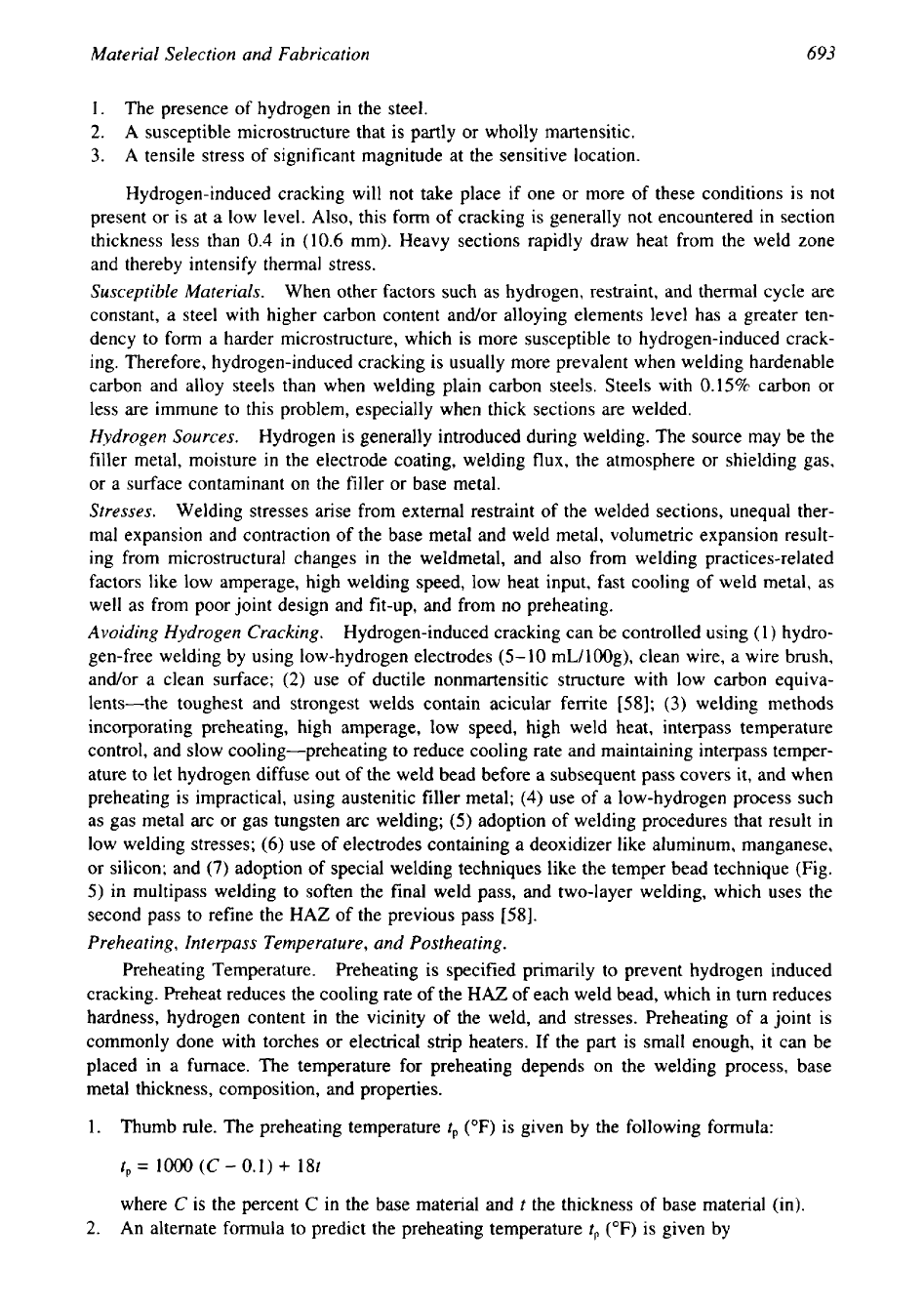
693
Material Selection and Fabrication
1.
The presence of hydrogen in the steel.
2.
A susceptible microstructure that is partly or wholly martensitic.
3.
A tensile stress of significant magnitude at the sensitive location.
Hydrogen-induced cracking will not take place if one or more of these conditions is not
present or is at a low level. Also, this form of cracking is generally not encountered in section
thickness less than
0.4
in
(10.6
mm). Heavy sections rapidly draw heat from the weld zone
and thereby intensify thermal stress.
Susceptible Materials.
When other factors such as hydrogen, restraint, and thermal cycle are
constant, a steel with higher carbon content and/or alloying elements level has a greater ten-
dency to form a harder microstructure, which is more susceptible to hydrogen-induced crack-
ing. Therefore, hydrogen-induced cracking is usually more prevalent when welding hardenable
carbon and alloy steels than when welding plain carbon steels. Steels with
0.15%
carbon or
less are immune to this problem, especially when thick sections are welded.
Hydrogen Sources.
Hydrogen is generally introduced during welding. The source may be the
filler metal, moisture in the electrode coating, welding flux, the atmosphere or shielding gas,
or a surface contaminant on the filler or base metal.
Stresses.
Welding stresses arise from external restraint of the welded sections, unequal ther-
mal expansion and contraction of the base metal and weld metal, volumetric expansion result-
ing from microstructural changes in the weldmetal, and also from welding practices-related
factors like low amperage, high welding speed, low heat input, fast cooling of weld metal, as
well as from poor joint design and fit-up, and from no preheating.
Avoiding Hydrogen Cracking.
Hydrogen-induced cracking can be controlled using
(
1)
hydro-
gen-free welding by using low-hydrogen electrodes (5-10 mWlOOg), clean wire, a wire brush,
andor a clean surface;
(2)
use of ductile nonmartensitic structure with low carbon equiva-
lents-the toughest and strongest welds contain acicular ferrite
[58];
(3)
welding methods
incorporating preheating, high amperage, low speed, high weld heat, interpass temperature
control, and slow cooling-preheating to reduce cooling rate and maintaining interpass temper-
ature to let hydrogen diffuse out of the weld bead before a subsequent pass covers it, and when
preheating is impractical, using austenitic filler metal;
(4)
use of a low-hydrogen process such
as gas metal arc or gas tungsten arc welding;
(5)
adoption of welding procedures that result in
low welding stresses;
(6)
use of electrodes containing
a
deoxidizer like aluminum, manganese,
or silicon; and
(7)
adoption of special welding techniques like the temper bead technique (Fig.
5)
in multipass welding to soften the final weld pass, and two-layer welding, which uses the
second pass to refine the HAZ of the previous pass
[58].
Preheating, Interpass Temperature, and Postheating.
Preheating Temperature.
Preheating is specified primarily to prevent hydrogen induced
cracking. Preheat reduces the cooling rate of the
HA2
of
each weld bead, which in turn reduces
hardness, hydrogen content in the vicinity
of
the weld, and stresses. Preheating of a joint is
commonly done with torches or electrical strip heaters. If the part is small enough, it can be
placed in a furnace. The temperature for preheating depends on the welding process, base
metal thickness, composition, and properties.
1.
Thumb rule. The preheating temperature
t,
(OF)
is given by the following formula:
t,
=
1000
(C
-
0.1)
+
18t
where
C
is the percent
C
in the base material and
t
the thickness of base material (in).
2.
An alternate formula to predict the preheating temperature
t,
(OF)
is given by
